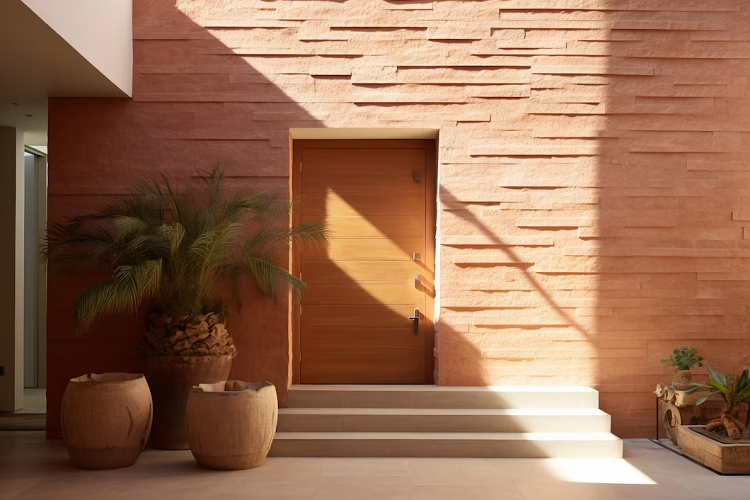 There is no denying the natural beauty of stone and brick, but it is expensive and can have an impact on the environment. That is part of the reason that stone veneer was invented as a more affordable product that does not require you to pull natural resources out of the earth. Is stone veneer really eco-friendly? In this article, we will examine that question.
There is no denying the natural beauty of stone and brick, but it is expensive and can have an impact on the environment. That is part of the reason that stone veneer was invented as a more affordable product that does not require you to pull natural resources out of the earth. Is stone veneer really eco-friendly? In this article, we will examine that question.
Stone Veneer vs. Natural Stone
You might be thinking that natural stone and brick are more sustainable than faux stone since they are not manufactured, but sometimes the faux material is better for the environment since it does not hurt the earth itself to create.
When you extract stone, rocks, or clay from the earth, it is not necessarily an eco-friendly process. Getting stone and rock out of the earth for the purposes of building typically requires the use of explosives to get to it. This means that the surrounding areas get demolished, too, which displaces animals and can destroy other natural resources. The machines used to harvest stones and rocks are usually diesel-powered, which pollutes the air and is noisy. Quarries also leave permanent scars on the natural landscape.
Natural stone is also a finite resource; we cannot just plant a new rock to replace the one that is being taken out of the ground.
Faux stone, on the other hand, does not require the destruction of landscape, nor does it pollute the air to create. Yet these panels have been expertly crafted to look and feel like the real thing.
1. Transportation
Transporting natural stone from a quarry requires a lot of energy since it is so heavy, and the trucks it is transported on can create a lot of air pollution to transport it. Faux stone is significantly more lightweight, so it does not require nearly as much energy to transport as natural stone does.
2. Durability
Natural stone is durable, but it can be chipped easily if hit hard enough, and it is not easy to repair or replace. Stone veneer, on the other hand, is highly durable, and it seldom needs to be replaced. When it is in need of repairs, the damaged panel can be replaced or repaired with ease, and the parts that need to be replaced can then be recycled.
3. Longevity
Both natural and faux stone can last for decades without issue. However, faux stone is also much lower maintenance than natural stone. It is also usually the more affordable option.
4. Pricing
Natural stone is expensive to purchase for home improvement projects. It is also not a DIY-friendly building material. Typically, natural stone requires the help of a professional mason to install, which makes it even more expensive than just the purchase of the materials. It has lengthy construction timelines and is something that can take a long time to complete the installation.
Faux stone is significantly more affordable than natural stone, so you will save money on the purchase. It is also DIY-friendly, so you will not need to hire a professional for the installation. Since it is DIY-friendly, many home improvement projects that use faux stone can be completed in just one weekend.
5. Structural Use of Stone
Stone veneer is usually comprised of panels, so it is not something that you can use to build a stone wall from scratch. However, since stone veneer looks like natural stone, it can be put on top of other materials to look like it is made of natural stacked stone.
6. Designs
Natural stone comes in all shapes and sizes, and so does stone veneer. With stone veneer, though, you can ensure that you are getting consistency in your color scheme, and you will not have to worry about there not being enough available in the color scheme you are aiming for. Plus, you can get faux stone that is customized to let you match your stone to the exact colors you need to make it work with your home.
Polyurethane Faux Stone
Some faux stone manufacturers make their products using polyurethane foam, which is a recyclable and sustainable product. Polyurethane is made by combining polyol and isocyanate, and it creates a small amount of CO2 emissions to create. Polyurethane is also recyclable. In fact, about 30 percent of the polyols that are in polyurethane come from recycling without impacting the performance of the polyurethane in any way.
While you are installing the faux stone on the walls, not in them, polyurethane makes an excellent form of insulation. It can help reduce your heating and cooling costs, which is another way that faux stone is eco-friendly.
Why Complete Eco-Friendly Home Improvement Projects?
When you are planning on completing some home improvement projects, aiming for eco-friendly ones is the best choice. Choosing an eco-friendly DIY project can help improve your health and well-being while potentially lowering your energy costs. In addition to using eco-friendly stone veneer, there are some other small projects you can complete to improve the energy efficiency of your home. Let’s take a look.
1. Install Energy-Efficient Lights
One of the easiest eco-friendly projects that you can complete is installing energy-efficient lighting. LED lights use significantly less energy than other types of lighting. They also do not need to be replaced as often as other types of light bulbs do.
In addition to getting LED lights, consider also getting smart lights. Smart bulbs usually connect to Wi-Fi, and they can be controlled through your phone or tablet. One of the great things about smart lights is that you will never need to remember to turn the lights off again. You can set them up to turn off and on automatically, and you can easily dim them. This may seem like it is not necessary, but it can be a worthwhile home improvement project.
2. Get Eco-Friendly Flooring
Hardwood flooring is beautiful and popular, but if you are replacing your existing flooring, you may want to consider something a little eco-friendly. The hardwood flooring that is currently out there is often not ethically sourced and contributes to the deforestation in Africa and Central America. There are some better, more eco-friendly alternatives.
- Green Bamboo Flooring
This is a much easier source of flooring that looks and feels like wood but is much more renewable than other types. It is resilient and comes in a wide variety of shades and colors, so you have options.
- Reclaimed Wood
Reclaimed or salvaged, wood comes from old furniture and buildings. This wood is still usable, and it allows the wood to be reused. It also helps keep wood out of landfills.
- Linoleum Flooring
Linoleum flooring is made from linseed oil, which is a binding agent that can be found in pine trees and is harvested without harming the trees themselves.
3. Replace the Curtains
To further improve the energy efficiency of your home, getting new curtains is a great idea. Try to choose some thicker curtains that will help reflect most of the sunlight entering the house, especially during the summer.
4. Seal or Upgrade the Windows and Doors
Are your doors or windows drafty? Up to 30 percent of home energy is lost because the air escapes through the drafty doors and windows. If you have high bills for your heating or cooling, upgrading your windows or doors to something more energy-efficient may be a good solution.
If you are not able to completely replace your current doors and windows, you can reseal them with weather stripping, caulk, door snakes, glaze, or other window treatments.
Is your doors and windows are drafty? There is a pretty easy way to test that. Light a candle and hold it next to a door or window. If the flame starts to bend, that means that the door or window is letting air escape.
5. Improve Insulation
Insulation is a big thing for cutting down your energy costs to make your home more eco-friendly. Just make sure that the insulation you choose is eco-friendly itself. Stone veneer is an excellent, eco-friendly insulation option that will improve the look of your home’s interior or exterior at the same time. Plus, it is designed for DIY installation. Make sure you spend some time researching the insulation options available to you before you commit to one so you know it will improve your home’s energy efficiency and that it is eco-friendly.
6. Use Eco-Friendly Paint
Paint can have volatile organic compounds in it that contain gasses that can be harmful to the health of you and others, plus the environment. If you decide to do any painting in your home for a home improvement project, make sure you choose a paint that does not contain any volatile organic compounds.
7. Get Energy-Efficient Appliances
While this is not necessarily something that counts as a home improvement project, replacing any of your old appliances can easily improve the energy efficiency of your home. Look for anything that is Energy Star certified. You can replace your refrigerator, dishwasher, washing machine, dryer, HVAC system, smart thermostat, and water heater.
Is Stone Veneer Eco-Friendly?
Yes, stone veneer is indeed eco-friendly. Its sustainable production, durability, energy efficiency, and recyclability make it a responsible choice for environmentally conscious homeowners. By selecting stone veneer for your home design projects, you can reduce your ecological footprint while enjoying the many benefits it offers.
Conclusion
In the quest for eco-friendly home design, stone veneer emerges as a sustainable choice. Its responsible sourcing, energy efficiency, durability, and recyclability all contribute to its eco-friendliness. By opting for stone veneer, you not only enhance the aesthetics of your home but also play a part in preserving our planet’s natural resources and reducing your environmental footprint. Make your home a sustainable haven with the timeless beauty of stone veneer.


